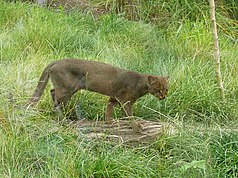Kaa-Iya del Gran Chaco National Park
| Kaa-Iya del Gran Chaco National Park | ||
|---|---|---|
| Jaguarundi | ||
|
|
||
| Location: | Santa Cruz , Bolivia | |
| Surface: | 34,411 km² | |
| Kaa-lya del Gran Chaco | ||
The National Park Kaa-Iya del Gran Chaco is the largest National Park in Bolivia and the second largest national park in South America . It protects the largest remaining remnants of the Gran Chaco dry forests and is home to the largest known individual population of the jaguar. The Bolivian Gran Chaco is a dry forest landscape with high temperatures and low rainfall. The huge wilderness is considered to be one of the last untouched bush and dry forest regions.
overview
The national park is located in the southern part of the Santa Cruz Department . It lies in the border area with Paraguay in the Gran Chaco region . The reserve is located on the northern edge of the Gran Chaco and protects the largest occurrence of the remaining dry forests in the Gran Chaco. The national park extends over an area of 3,400,000 ha (34,400.00 km²). The protected area extends on a flat hilly plain, which is about 300 m above sea level. The average annual rainfall is 700–800 mm, the average annual temperature is around 25 ° C. In the east bordering indigenous territory of the Guaraní to the National Park. The most important river is the Río Parapetí .
vegetation
The dry forests of the national park are typical of the Gran Chaco. The canopy is around 10 to 15 meters, the undergrowth is dominated by bromeliads and cacti . 1500 plant species have been found in the national park.
fauna
The protected area is home to over 350 species of animals. A more recent study carried out with chamber traps came to the conclusion that there may be up to a thousand jaguars in the national park area . This means that the reserve is probably home to the largest single population of the threatened big cat known worldwide. In the areas examined, there were around two to five jaguars per hundred square kilometers. The second largest cat in South America, the puma , is also found in fairly high population densities. Furthermore, the national park is likely to be home to more than six thousand lowland tapirs, which is surprisingly high, since the dry forests of the area are generally not considered an ideal habitat for these animals. One of the species that are particularly characteristic of the Chaco dry forests and native to Kaa-Iya del Gran Chaco is the Chaco peccary . The park is also home to numerous smaller predators such as the ocelot , spotted cat , jaguarundi , pampas fox and mayong . In addition to the pampas fox and the Maikong, the forest dog , a third type of canid, has recently been identified in the national park. The maned wolf, on the other hand, does not appear to appear. There is also a population of guanacos in the southwest of the national park . The guanacos of the Gran Chaco are often regarded as a separate subspecies ( Lama guanicoe voglii ).
population
There are about twenty Guaraní communities in the national park , but only a few people live in the impenetrable bushland of the Kaa-Iya National Park.
See also
Individual evidence
- ↑ a b c Marcella J. Kelly, Andrew J. Noss, Mario S. Di Bitettic, Leonardo Maffei, Rosario L. Arispe, Agustin Paviolo, Carlos D. De Angelo, and Yamil E. Di Blanco: Estimating Puma Densities from Camera Trapping across Three Study Sites: Bolivia, Argentina, and Belize. Journal of Mammalogy , 89 (2): 408-418, 2008 online PDF
- ↑ Leonardo Maffei, Erika Cuéllar, Andrew Noss: One thousand jaguars ( Panthera onca ) in Bolivia's Chaco? Camera trapping in the Kaa-Iya National Park. Journal of Zoology, Volume 262, Issue 3, pages 295–304, March 2004 ( online abstract )
- ↑ AJ Noss, RL Cuéllar, J. Barrientos, L. Maffei, E. Cuéllar, R. Arispe, D. Rúmiz & K. Rivero: A Camera Trapping and Radio Telemetry Study of Lowland Tapir ( Tapirus terrestris ) in Bolivian Dry Forests. June 2003 Vol. 12 / No. 1 n Tapir Conservation n Newsletter of the IUCN / SSC Tapir Specialist Group. online PDF
- ↑ Catagonus wagneri in the Red List of Threatened Species of the IUCN 2011. Posted by: Altrichter, M., Taber, A., Noss, A. & Maffei, L., 2008. Retrieved on August 12, 2011.
- ↑ Christine V. Fiorello, Andrew J. Noss, Sharon L. Deem, Leonardo Maffei, and Edward J. Dubov (2007): Serosurvey of Small Carnivores in the Bolivian Chaco . Journal of Wildlife Diseases, 43 (3), 2007, pp. 551-557.
- ↑ L. Maffei, R. Paredes, A. Segundo, A. Noss: Home range and activity of two sympatric fox species in the Bolivian Dry Chaco . Canid News, IUCN / SSC Canid Specialist Group, 2007. online PDF
- ^ Jorge Segundo, Gregorio Castro, Erika Cuéllar (2004). Uso de hábitat por el guanaco ( Lama guanicoe ) en el suroeste del Parque Nacional Kaa-Iya, Santa Cruz, Bolivia . MEMORIAS: Manejo de Fauna Silvestre en Amazonia y Latinoamérica. Memoria VI Congreso sobre Manejo de Fauna Silvestre en la Amazonía y Latinoamerica. pp. 279-282. online PDF ( page no longer available , search in web archives ) Info: The link was automatically marked as defective. Please check the link according to the instructions and then remove this notice.


